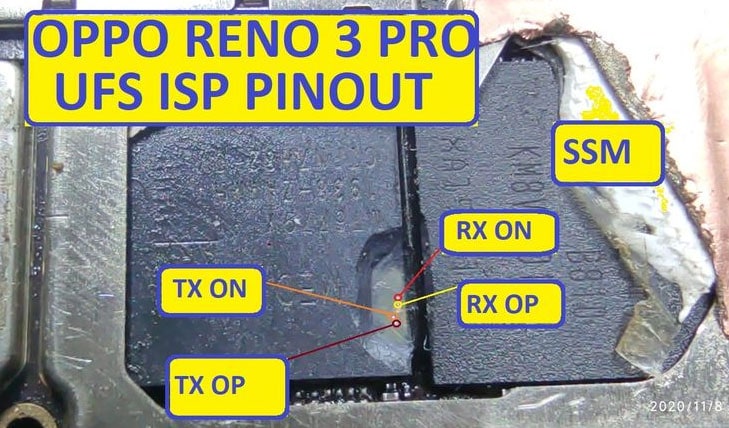The next-gen OPPO Reno3 Pro has been launched in China very recently with plenty of improvements and changes to the device and its features. The device is the successor version of the Reno2 series and offers a stunning display with curved edges just like Samsung’s flagship devices. It has a punch-hole camera for the selfies and the display offers a 90Hz refresh rate, new SDM675G SoC, and more.
In this guide, we will show you the real image of the UFS ISP pinout and test point for the Oppo Reno 3 Pro CPH2035. By using the ISP PinOUT, you can easily restore the stock ROM, bypass FRP lock, or reset user data on your device via Z3X EasyJTag Box Tool.
Page Contents
What is ISP PinOUT?
ISP or In-system programming also known as in-circuit serial programming (ICSP) for hardware that has a cross-reference of pins or contacts. By shorting the pins together, you can power or signal the logic board (motherboard) of an electronic device such as a mobile, computer. You will find the IS Pinout connection on the logic board of your device. Therefore, you will need to remove the back panel of the handset and follow the below image to locate the pinout.
Oppo Reno 3 Pro (CPH2035) UFS ISP Pinout Image:

I hope this guide was helpful to find the Oppo Reno 3 Pro CPH2035 UFS ISP Pinout Testpoint.
Oppo Reno 3 Pro Specifications:
The device comes with a 6.5-inches AMOLED Full-HD+ display with 1080×2400 pixels resolution. It offers more than 89% screen-to-body ratio, 402 ppi pixel density, a 90Hz refresh rate, 1100 nits brightness, DCI-P3 color gamut, and protected with Corning Gorilla Glass 5. It’s powered by the octa-core Qualcomm Snapdragon 765 SoC and paired with Adreno 620 GPU. The handset runs on Android 10 over ColorOS 7 skin.
It packs 8GB/12GB of RAM and 128GB/256GB of internal storage option. There is no expandable storage option available. It sports a quad rear camera setup of a 48MP primary (wide, f/1.7) + a 13MP (telephoto, f/2.4) + an 8MP (ultrawide, f/2.2) + a 2MP (B/W, f/2.4) lens. The rear cameras support PDAF, OIS, 2x optical zoom, Dual-LED flash, HDR, Panorama, etc. While the front packs a 32MP punch-hole selfie camera on the upper left corner of the display with a wide-angle f/2.4 lens.
The device includes Wi-Fi 802.11 a/b/g/n/ac/ax (dual-band), USB Type-C, Bluetooth 5.1, GPS, A-GPS, GLONASS, NFC, etc. While there are some of the major sensors also available like an in-display fingerprint sensor, an accelerometer, gyro, proximity, compass sensor. It packs a 4,025mAh battery with 30W fast charging support.
